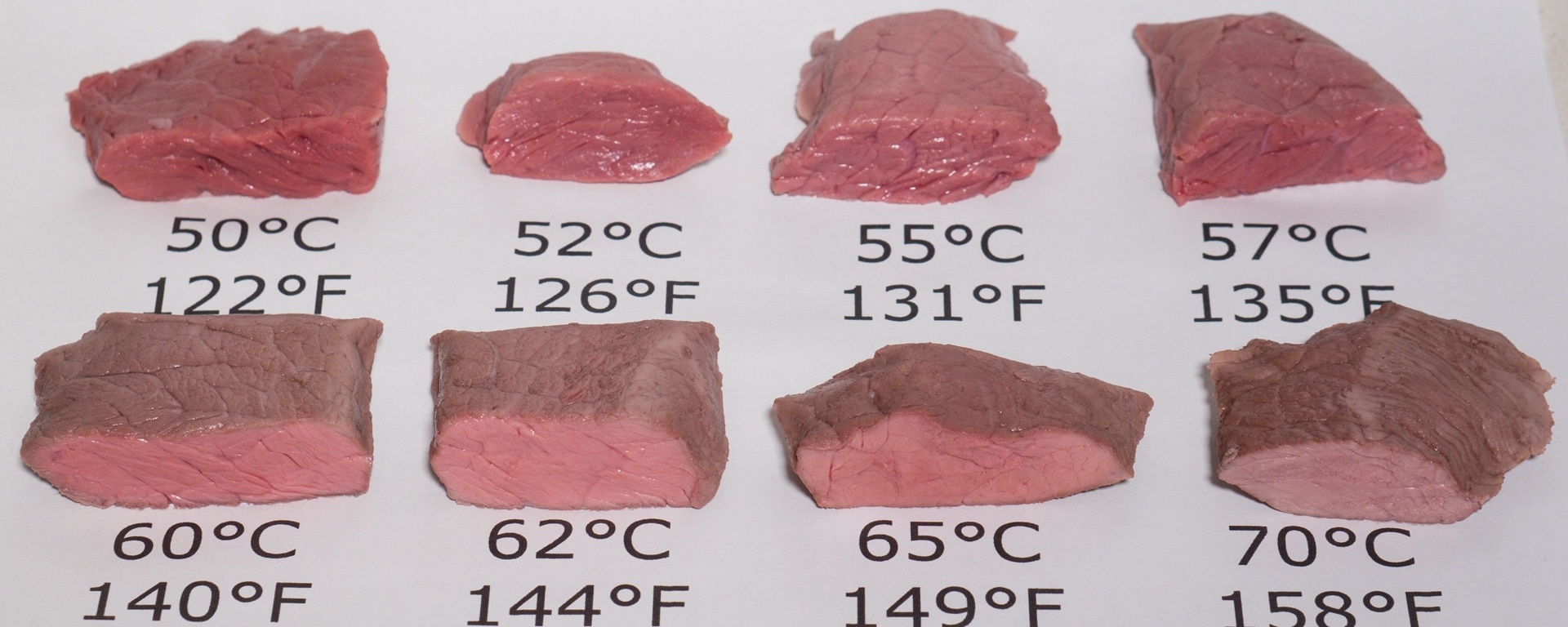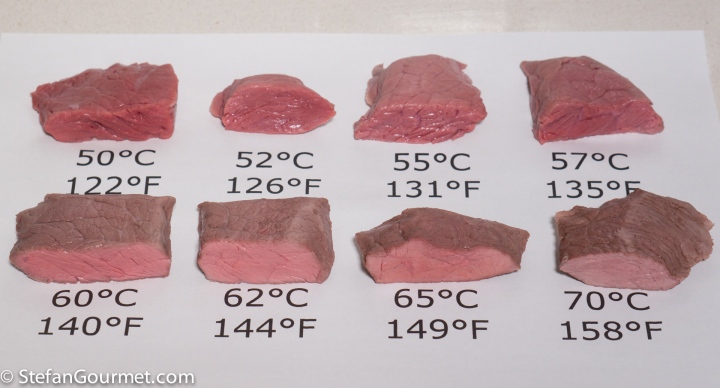When cooking sous-vide, you have perfect control over how done the meat is going to be. But it does require you to know what temperature corresponds with how you like your steak done. And so I prepared the above chart for you. You can look at what the meat will look like in the photo, or use this list:
- rare: 50C/122F
- medium-rare: 55C/131F
- medium: 60C/140F
- medium-well: 65C/149F
- well-done: 70C/158F (or even higher)
The same temperature chart also applies when cooking red meat in a pan, on a grill, or in the oven, when you use a thermometer to measure the core temperature.
There are three things that will happen when you increase the cooking temperature compared to cooking at a lower temperature:
- More juices will be squeezed out of the meat, so the lower the temperature, the more juicy
- More connective tissue will be broken down, so the higher the temperature, the more tender (but it may not seem more tender because of the loss of juices)
- From 60C/140F and above, the myoglobin will break down, and since that is what makes the meat red, it will become less red. The higher the temperature, the faster this will go. But if you cook for long enough at 60C/140F, the color will be gone by just as much as when cooked for a shorter time at 70C/158F.
You can read more about what cooking meat does to juiciness, tenderness, or the color in the series of articles that I wrote before.
How did I produce these charts? I started with 8 pieces of rump steak from the same piece of beef.
I vacuum sealed and labeled them, taking note of the initial weight.
Then I cooked each one sous-vide for 15 minutes at the indicated temperature. Since the pieces of steak were only about 1 cm (less than 1/2 inch) thick, 15 minutes was enough for the core temperature to reach the target temperature.
After cooking sous-vide, I weighed them again to measure the loss of juices. My favorite one was medium-rare, cooked at 55C/131F.
Since all red meat behaves more or less the same, this chart is not just for steak, but for any red meat:
- beef
- lamb
- venison
- bison
- kangaroo
- ostrich
- duck







I love these experiments of yours with the sous vide.
LikeLiked by 1 person
And I presume you then need the very minimum in a sizzling hot pan to brown it. Where would you put bleu and saignant on this chart?
LikeLike
Yes, but browning it will increase the cooking if you don’t allow it to cool off a bit first.
Bleu is very rare and not in the chart (about 47C/116F).
Saignant is rare.
LikeLiked by 1 person
The pictures are really helpful – particularly as they’re all from the same piece of meat. What are your thoughts on the food safety aspect for such a short cooking time?
LikeLiked by 1 person
The short cooking time does not matter as long as the steak is seared on the outside before serving (which I did) and as long as you are not serving it to pregnant women. You could read more about food safety here: https://stefangourmet.com/2016/11/27/understanding-food-safety/
LikeLike
Great. This should be in every hobby-cooks kitchen 🙂
Cheers !
LikeLiked by 1 person
scheda tecnica 🙂
LikeLiked by 1 person
Great tips!
LikeLiked by 1 person
Grazie!
LikeLiked by 1 person
Hi Stefan, great experiment.
For steak, I’m applying Archimedes’ technique (meat in bag underwater, not even sealed as cooking times are short).
Vacuum in itself does remove juice from the meat – can you guess how much?
Cheers .. Wolfgang
LikeLiked by 1 person